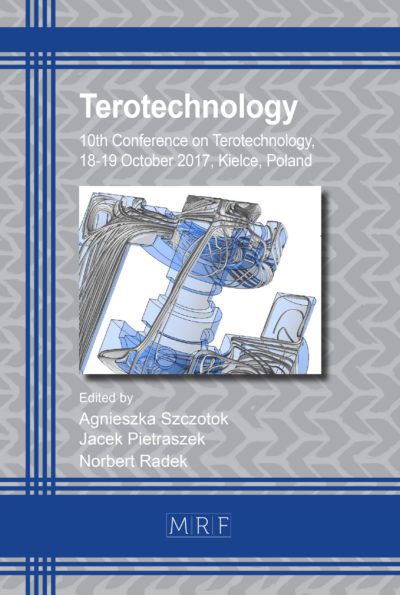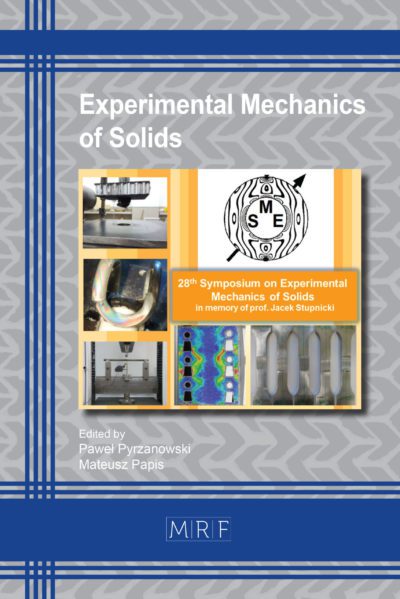Adaptive mesh refinement for efficient random cellular automata finite element analysis in complex geometries
Mateusz SITKO, Kacper PAWLIKOWSKI, Konrad PERZYNSKI, Lukasz MADEJ
Abstract. Proper mesh discretization plays a crucial role in the accuracy of simulations using the coupled Random Cellular Automata Finite Element (RCAFE) method for modelling complex microstructure evolution problems like dynamic recrystallization (DRX). The mesh quality directly impacts the stability, convergence, and precision of FE simulations, making it a critical factor in achieving reliable results in the RCAFE model. Traditional mesh generation techniques face significant challenges when handling complex geometries, ensuring adaptive refinement, and maintaining mesh quality in high-gradient regions or anisotropic material models. Therefore, this paper focuses on developing a solution for adaptive remeshing tailored to the specific needs of RCAFE DRX simulations within commercial finite element Abaqus software. The process involves designing material-specific meshes based on digital microstructure morphology, utilizing structured meshes for homogeneous materials and heterogeneous meshes for complex microstructures such as dual-phase steels or multi-phase composites. The developed algorithmic solutions for automation of mesh modifications corresponding to the evolving microstructure morphology are presented within the work. Such an approach enables the efficient creation of high-quality, material-specific meshes in each time step, thereby improving the robustness and efficiency of RCAFE simulations across diverse applications.
Keywords
Random Cellular Automata, Finite Element Method, Mesh Generation
Published online 5/7/2025, 8 pages
Copyright © 2025 by the author(s)
Published under license by Materials Research Forum LLC., Millersville PA, USA
Citation: Mateusz SITKO, Kacper PAWLIKOWSKI, Konrad PERZYNSKI, Lukasz MADEJ, Adaptive mesh refinement for efficient random cellular automata finite element analysis in complex geometries, Materials Research Proceedings, Vol. 54, pp 1945-1952, 2025
DOI: https://doi.org/10.21741/9781644903599-209
The article was published as article 209 of the book Material Forming
![]() Content from this work may be used under the terms of the Creative Commons Attribution 3.0 license. Any further distribution of this work must maintain attribution to the author(s) and the title of the work, journal citation and DOI.
Content from this work may be used under the terms of the Creative Commons Attribution 3.0 license. Any further distribution of this work must maintain attribution to the author(s) and the title of the work, journal citation and DOI.
References
[1] K. Huang, R.E. Logé, A review of dynamic recrystallization phenomena in metallic materials, Mater Des 111 (2016) 548–574. https://doi.org/10.1016/j.matdes.2016.09.012
[2] M. Bernacki, R.E. Logé, T. Coupez, Level set framework for the finite-element modelling of recrystallization and grain growth in polycrystalline materials, Scr Mater 64 (2011) 525–528. https://doi.org/10.1016/j.scriptamat.2010.11.032
[3] T. Takaki, A. Yamanaka, Y. Tomita, Phase-field modeling for dynamic recrystallization, Advanced Structured Materials 64 (2015) 441–459. https://doi.org/10.1007/978-3-319-19440-0_20
[4] M. Bernacki, Kinetic equations and level-set approach for simulating solid-state microstructure evolutions at the mesoscopic scale: State of the art, limitations, and prospects, Prog Mater Sci 142 (2024) 101224. https://doi.org/10.1016/j.pmatsci.2023.101224
[5] R.L. Goetz, V. Seetharaman, Modeling dynamic recrystallization using cellular automata, Scr Mater 38 (1998) 405–413. https://doi.org/10.1016/S1359-6462(97)00500-9
[6] N. Xiao, C. Zheng, D. Li, Y. Li, A simulation of dynamic recrystallization by coupling a cellular automaton method with a topology deformation technique, Comput Mater Sci 41 (2008) 366–374. https://doi.org/10.1016/j.commatsci.2007.04.021
[7] J. Gawąd, M. Pietrzyk, Application of cafe multiscale model to description of microstructure development during dynamic recrystallization, 2007.
[8] H. Hallberg, M. Wallin, M. Ristinmaa, Simulation of discontinuous dynamic recrystallization in pure Cu using a probabilistic cellular automaton, Comput Mater Sci 49 (2010) 25–34. https://doi.org/10.1016/j.commatsci.2010.04.012
[9] N. Yazdipour, C.H.J. Davies, P.D. Hodgson, Microstructural modeling of dynamic recrystallization using irregular cellular automata, Comput Mater Sci 44 (2008) 566–576. https://doi.org/10.1016/j.commatsci.2008.04.027
[10] H. Li, X. Sun, H. Yang, A three-dimensional cellular automata-crystal plasticity finite element model for predicting the multiscale interaction among heterogeneous deformation, DRX microstructural evolution and mechanical responses in titanium alloys, Int J Plast 87 (2016) 154–180. https://doi.org/10.1016/j.ijplas.2016.09.008
[11] M. Sitko, K. Pawlikowski, K. Perzynski, L. Madej, Mesh sensitivity study in the random cellular automata finite element model of dynamic recrystallization, in: Materials Research Proceedings, 2024: pp. 2271–2277. https://doi.org/10.21741/9781644903131-250
[12] M. Sitko, M. Czarnecki, K. Pawlikowski, L. Madej, Evaluation of the effectiveness of neighbors’ selection algorithms in the random cellular automata model of unconstrained grain growth, Materials and Manufacturing Processes (2023) 1–11. https://doi.org/10.1080/10426914.2023.2196753
[13] P. Zoghipour, K.A. Hasim, A. Kefal, M. Yildiz, Implementation of shear-locking-free triangular refined zigzag element for structural analysis of multilayered plates with curvilinear fibers, Compos Struct 305 (2023). https://doi.org/10.1016/j.compstruct.2022.116462














